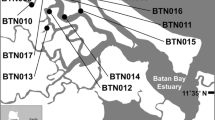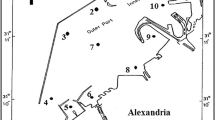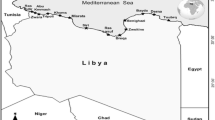Abstract
Partitioning of heavy metals (Cd, Cr, Cu, Pb, Zn) in marine sediments collected from various sites in Hong Kong waters were determined using sequential extraction method. Sediments from Kellette Bank, located in Victoria Harbour, had higher metal concentrations especially Cu and Zn than most other sites. Slightly over 20% of total Cu and Cr existed as readily available forms in Peng Chau and Kellette Bank. At most sampling sites, over 15% of the Cu existed as the exchangeable form indicating that Cu could be readily released into the aqueous phase from sediments. A significantly higher percentage of Pb and Zn was associated with the three non-residual fractions. Hence, there is a greater environmental concern for remobilization of Pb and Zn compared with Cr. The high amount of residual Cd (>50%) and the relatively lower Cd content indicate that little environmental concern is warranted for the remobilization of Cd. Distribution of metals in sediments collected from different depth at Kellette Bank shows that metal concentrations decreased with profile depth. The levels of Pb and Zn associated with the two readily available fractions increased sharply in the surface sediment. These metals represented the pollutants, which were introduced into the area in the mid-eighties through early nineties as a result of rapid economic and industrial development in the territory. As significant portions of these metals were bound to the readily available phases in the surface sediments, metal remobilization could be a concern.



Similar content being viewed by others

References
Bernhard M, Brinckman FE, Itgolic KJ (1986) Why “speciation?” In: Bernhard M, Brinckman FE, Sadler PJ (eds) The importance of chemical “speciation” in environmental processes. Springer, Berlin Heidelberg New York, pp 7–14
Borovec Z (1996) Evaluation of the concentrations of trace elements in stream sediments by factor and cluster analysis and the sequential extraction procedure. Sci Total Environ 177:237–250
Calmano W, Hong J, Förstner U (1993) Binding and mobilization of heavy metals in contaminated sediments affected by pH and redox potential. Wat Sci Technol 28:223–235
Calmano W, Wolfgang A, Förstner U (1990) Exchange of heavy metals between sediment components and water. In: Broedaert AC, Gucer S, Adams F (eds) Metal speciation in the environment. NATO ASI Series G: Ecological Science, vol 23. Springer, Berlin Heidelberg New York, pp 503–522
Environmental Protection Department (1998) Marine water quality in Hong Kong in 1997. Government Printer, Hong Kong
Förstner U (1983) Assessment of metal pollution in rivers and estuaries. In: Thornton I (ed) Applied environmental geochemistry. Academic, London, pp 395–423
Förstner U (1985) Chemical forms and reactivities of metals in sediments. In: Leshber R, Davis RD, L’Hermite P (eds) Chemical methods for assessing bio-available metals in sludges and soils. Elsevier, London, pp 1–30
Förstner U (1989) Contaminated sediments. In: Bhattacharji S, Friedman GM, Neugebauer HJ, Seilacher A, eds., Lecture Notes in Earth Sciences, vol 21. Berlin Heidelberg New York: Springer-Verlag
Guevara-Riba A, Sahuquillo A, Rubio R, Rauret G (2004) Assessment of metal mobility in dredged harbour sediments from Barcelona, Spain. Sci Total Environ 321(1–3):241–255
Horowitz AJ, Elrick KA, Hooper RP (1989) Prediction of aquatic sediment-associated trace element concentrations using selected geochemical factors. Hydrol Process 3:347–364
Kersten M, Förstner U (1991) Speciation of trace elements in sediments. In: Batley GE (eds) Trace element speciation: analytical methods and problems. CRC Press, Boca-Raton, pp 245–317
Lager T, Hamer K, Schulz HD (2005) Mobility of heavy metals in harbour sediments: an environmental aspect for the reuse of contaminated dredged sediments. Environ Geol 48(1):92–100
Li XD, Wai OW H, Li YS, Coles BJ, Ramsey MH, Thornton I (2000) Heavy metal distribution in sediment profiles of the Pearl River estuary, South China. Appl Geochem 15:567–581
Nystrom GM, Ottosen LM, Villumsen A (2003) The use of sequential extraction to evaluate the remediation potential of heavy metals from contaminated harbour sediment. J Physique IV 107(2):975–978
Oakley SM, Nelson PO, Williamson KJ (1981) Model of trace-metal partitioning in marine sediments. Environ Sci Technol 15:475–480
Panda D, Subramanian V, Panigrahy RC (1995) Geochemical fractionation of heavy metals in Chika Lake (east coast of India)––a tropical coastal lagoon. Environ Geol 26:199–221
Pardo R, Barrado E, Perez L, Vega M (1990) Determination and speciation of heavy metals in sediments of the Posuerga River. Water Res 24:373–379
Pulford ID, Bakhsh A (1989) Uptake of zinc by soil: adsorption or precipitation? In: Proceedings of international conference on heavy metals in the environments, vol 2, pp 193–196
Rauret G, Tubio R, Lopez-Sanchez JF, Casassas E (1988) Determination and speciation of copper and lead in sediments of a Mediterranean river (River Tenes, Catalonia, Spain). Water Res 22:449–455
Schintu M, Degetto S (1999) Sedimentary records of heavy metals in the industrial harbour of Portovesme, Sardinia (Italy). Sci Total Environ 241:129–141
Sin SN, Chua H, Lo W, Ng LM (2001) Assessment of heavy metal cations in sediments of Shing Mun River, Hong Kong. Environ Int 26(5–6):297–301
Stumm W, Morgan JJ (1981) Aquatic chemistry: an introduction emphasizing chemical equilibria in natural waters, 2nd edn. Wiley, New York
Szefer P, Glasby GP, Penpkowiak J, Kaliszan R (1995) Extraction studies of heavy-metal pollutants in surficial sediments from the Southern Baltic Sea of Poland. Chem Geol 120:111–126
Tessier A, Campbell PGC, Bison M (1979) Sequential extraction procedure for the speciation of particulate metals. Anal Chem 51:844–851
Usero U, Gamero M, Morillo J, Gracia I (1998) Comparative study of three sequential extraction procedures for metals in marine sediments. Environ Int 24:487–496
van den Hurk P, Eertman RHM, Strokhorst J (1997) Toxicity of harbour canal sediments before dredging and after off-shore disposal. Mar Pollut Bull 34(4):586–590
Zhou HY, Cheung RYH, Chan KM, Wong MH (1998) Metal concentrations in sediments and Tila Pia collected from inland waters of Hong Kong. Water Res 32:3331–3340
Acknowledgments
The authors wish to express their sincere gratitude to the Hong Kong Research Grants Council (PolyU 5058/02E) for the support of this research.
Author information
Authors and Affiliations
Corresponding author
Additional information
An erratum to this article can be found at http://dx.doi.org/10.1007/s00254-006-0629-y
Rights and permissions
About this article
Cite this article
Choi, S.C., Wai, O.W.H., Choi, T.W.H. et al. Distribution of cadmium, chromium, copper, lead and zinc in marine sediments in Hong Kong waters. Environ Geol 51, 455–461 (2006). https://doi.org/10.1007/s00254-006-0340-z
Received:
Accepted:
Published:
Issue Date:
DOI: https://doi.org/10.1007/s00254-006-0340-z



